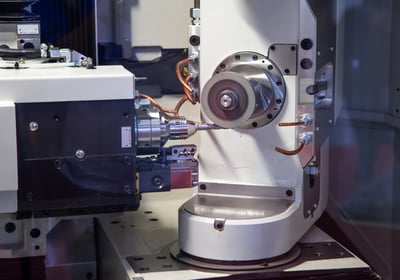Tungsten Carbide Grinding Basics
What is Tungsten Carbide?
Tungsten carbide (WC) is a compound made from equal parts tungsten and carbon. The combination produces an exceptionally dense, hard material—nearly twice as strong as steel and about ten times harder than 18-karat gold. In its raw form, tungsten carbide is a fine gray powder, which is then sintered under heat and pressure to form a solid with remarkable wear resistance.

Carbide’s hardness, combined with its ability to hold a sharp edge, makes it ideal for cutting, drilling, and forming other hard materials. It’s used in everything from cutting tools and dies to wear parts, valves, mining components, and surgical instruments. In many ways, tungsten carbide bridges the gap between metal and ceramic—it has the toughness of the former and the hardness of the latter.
Why Carbide is difficult to Grind
Tungsten carbide is extremely hard—around 9 on the Mohs scale—and very wear-resistant. Conventional abrasives such as aluminum oxide or silicon carbide dull quickly on carbide, generate excessive heat, and leave poor finishes.
A Diamond Wheel is the only practical wheel for grinding tungsten carbide. Its extreme hardness and high thermal conductivity allow it to cut the carbide grains cleanly (rather than plow), control heat in the contact zone, and hold form for tight tolerances.
Why not a CBN Wheel?
CBN is engineered for ferrous alloys (steels, tool steels, superalloys with iron). When used to grind tungsten carbide, CBN wheels wear rapidly because:
-
It has lower hardness than diamond and is not efficient against WC grains.
-
It tends to rub and plow rather than shear, increasing heat and degrading surface integrity.
-
It delivers short wheel life and poor economics on carbide compared with diamond.
The role of Bond Systems and Coolant
Grinding tungsten carbide efficiently depends on more than the abrasive itself. The bond system, which holds the abrasive grains in place, determines how the wheel performs under pressure and heat.
- Metal bonds provide strength and thermal stability for aggressive cuts.
- Resin bonds offer flexibility and a cooler grind, making them ideal for finishing operations.
- Hybrid bonds combine these traits, balancing wheel life and cutting rate.
Equally important is coolant selection. Carbide grinding produces extreme frictional heat. Without proper coolant, thermal cracking or micro-fracturing can occur in both the part and the wheel. Using a dedicated grinding coolant—such as those formulated for diamond and CBN wheels—helps control temperature, remove swarf, and maintain wheel sharpness. Clean, filtered coolant also minimizes wheel loading and prolongs life.
Key Grinding Parameters
To achieve precision results on carbide components, several factors must be optimized:
- Wheel speed (surface feet per minute) – Determines how aggressively the wheel cuts; excessive speed can lead to heat buildup.
- Feed rate and depth of cut – Must balance material removal with surface integrity; too high and the carbide may chip.
- Coolant delivery – Should be directed precisely at the contact zone for maximum heat removal.
- Dressing and conditioning – Maintains a clean, open wheel surface for consistent cutting.
A well-controlled grinding setup ensures not only accuracy and surface quality but also longer wheel life and lower cost per part.
Industries where Carbide Grinding is Required
Because of its hardness, tungsten carbide is the material of choice for high-performance parts in demanding environments. You’ll find carbide in:
- Cutting and forming tools – drills, end mills, reamers, punches, and dies
- Aerospace and automotive components – wear parts, valve seats, and tooling inserts
- Medical instruments – precision cutters and dental burrs
- Mining and energy – downhole tools and nozzles exposed to abrasive slurries
In each of these industries, accurate and repeatable grinding determines whether the part performs as designed.
Diamond Wheels and Their Advantages
Diamond grinding wheels are the benchmark for carbide machining because diamond is harder than any other abrasive. The tightly bonded diamond particles shear the carbide rather than plow through it, resulting in minimal heat, high precision, and fine surface finishes.
The grit size and bond type dictate performance:
- Coarse grit – for rough grinding or high stock removal
- Medium grit – for general-purpose work
- Fine grit – for polishing or final finishing where surface quality matters most
Modern diamond wheels, such as those engineered by Eagle Superabrasives, are designed to maintain sharp cutting edges, resist loading, and run cooler for improved part accuracy.
Summary
Grinding tungsten carbide is one of the most demanding abrasive machining processes in industry. Success depends on a deep understanding of the material, the right type of diamond abrasives, and the proper setup of bond, grit, and coolant. When executed correctly, carbide grinding yields exceptional precision, mirror-like surface finishes, and long-lasting parts that perform under extreme conditions.
At Eagle Superabrasives, we support manufacturers across industries who rely on carbide every day. Whether you’re finishing tools, components, or wear parts, our diamond and CBN wheels are built to meet the toughest grinding requirements—delivering reliability, efficiency, and performance in every pass.
Recent Posts
Subscribe to email updates
Subscribe to our blog to get the latest updates from the experts on Grinding Wheels! You can easily unsubscribe at any time




